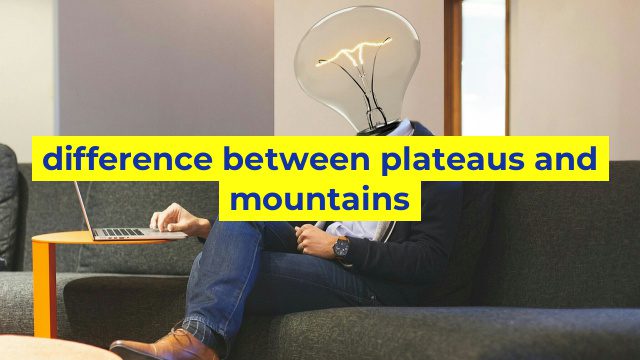Difference between Plateaus and Mountains
When it comes to geographical features, plateaus and mountains appear quite similar, but there are significant differences between them. These differences can help you understand the distinct characteristics of each landform.
What is a Plateau?
A plateau is a flat and elevated landform that stands at an altitude of around 500 meters or more above sea level. Unlike mountains, plateaus are usually surrounded by steep slopes that drop off suddenly on at least one side. They are generally situated between two or more mountain ranges.
Plateaus are typically thousands of square kilometers in size and are often formed by volcanic eruptions, tectonic uplifts, or erosion. They are sometimes referred to as ‘tablelands’ and are known for their high nutrient content and fertile soil, making them an important agricultural resource.
What is a Mountain?
A mountain, on the other hand, is a raised landform that can extend from a few hundred meters to several thousand meters above sea level. Mountains are characterized by steep slopes that usually rise above the surrounding terrain, reaching up to a peak or a summit. They are generally formed by the same geological processes as plateaus, such as tectonic uplifts and volcanic activity.
Mountains are often associated with snow-capped peaks and are home to a range of biodiversity, including flora and fauna that are adapted to the harsh climatic conditions.
The Main Differences between Plateaus and Mountains
One of the main differences between plateaus and mountains is their elevation. Although both are elevated above sea level, plateaus are generally much flatter and less steep than mountains. Also, plateaus are surrounded by steep slopes on at least one of their sides, while mountains have steep slopes on all their sides.
Another important difference is their geological formation. Plateaus are often the result of slow geological processes such as tectonic uplifts and erosion, while mountains are typically formed by sudden and violent weather events, such as volcanic eruptions.
Finally, plateaus tend to have more fertile soil and higher nutrient content than mountains, making them ideal for agriculture, while mountains are associated with colder climates and a greater range of flora and fauna.
In conclusion, although both landforms may appear similar at first glance, plateaus and mountains are distinct features with specific characteristics. Understanding these differences can help appreciate the geological diversity of our planet.
Table difference between plateaus and mountains
| Plateaus | Mountains |
|---|---|
| Flat or gently sloping land with high elevation | High elevations with steep slopes and peaks |
| Formed by a process of uplift and erosion | Formed by the collision of tectonic plates |
| Often surrounded by steep cliffs or escarpments | Often surrounded by deep canyons and valleys |
| Can support agriculture due to fertile soil and access to water sources | Difficult to farm due to the steep terrain and harsh weather conditions |
| Examples include the Tibetan Plateau and the Colorado Plateau | Examples include the Himalayas and the Rocky Mountains |

